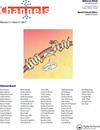膜双层厚度对KcsA通道活性的影响
IF 3.2
3区 生物学
Q2 BIOCHEMISTRY & MOLECULAR BIOLOGY
引用次数: 12
摘要
原子分辨率结构为各种离子通道(包括钾离子通道)的门控和渗透机制提供了重要的见解。然而,离子通道也可能受到许多因素的调节,包括它们所嵌入的膜的物理化学性质。例如,双分子层的疏水区域与离子通道的疏水外表面的匹配被认为可以最大限度地减少溶剂化疏水残基或暴露的脂质尾部所需的能量惩罚。要了解这种疏水匹配调节的分子基础,需要在脂质膜存在的情况下检查通道。在这里,我们研究了疏水匹配在调节模式钾通道KcsA活性中的作用。86Rb+内流试验和单通道记录表明,非失活的E71A KcsA通道在薄双层中最活跃(The influence of membrane bilayer thickness on KcsA channel activity
ABSTRACT Atomic resolution structures have provided significant insight into the gating and permeation mechanisms of various ion channels, including potassium channels. However, ion channels may also be regulated by numerous factors, including the physiochemical properties of the membrane in which they are embedded. For example, the matching of the bilayer’s hydrophobic region to the hydrophobic external surface of the ion channel is thought to minimize the energetic penalty needed to solvate hydrophobic residues or exposed lipid tails. To understand the molecular basis of such regulation by hydrophobic matching requires examining channels in the presence of the lipid membrane. Here we examine the role of hydrophobic matching in regulating the activity of the model potassium channel, KcsA. 86Rb+ influx assays and single-channel recordings indicate that the non-inactivating E71A KcsA channel is most active in thin bilayers (
求助全文
通过发布文献求助,成功后即可免费获取论文全文。
去求助
来源期刊

Channels
生物-生化与分子生物学
CiteScore
5.90
自引率
0.00%
发文量
21
审稿时长
6-12 weeks
期刊介绍:
Channels is an open access journal for all aspects of ion channel research. The journal publishes high quality papers that shed new light on ion channel and ion transporter/exchanger function, structure, biophysics, pharmacology, and regulation in health and disease.
Channels welcomes interdisciplinary approaches that address ion channel physiology in areas such as neuroscience, cardiovascular sciences, cancer research, endocrinology, and gastroenterology. Our aim is to foster communication among the ion channel and transporter communities and facilitate the advancement of the field.
 求助内容:
求助内容: 应助结果提醒方式:
应助结果提醒方式:


